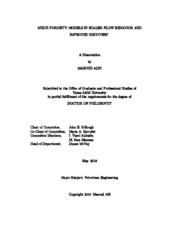| dc.description.abstract | The first part of this work proposes a partitioning scheme to divide porous media in shale into three different sub-media (porosity systems) with distinctive characteristics: inorganic matter and kerogen (in the shale matrix), along with fracture network (natural or hydraulic). This partitioning scheme is then deployed on a micro-scale model, which gives us the capability of analyzing the complex nature of mass transfer in shale. Current model can also handle various flow and storage mechanisms related with hydrocarbon production in shale such as molecule/wall interactions and slippage of the gas phase, multicomponent desorption, and capillarities. Although kerogen is considered to be a rich source of hydrocarbon, a relatively high capillary pressure and very low rock permeability hinder oil production in organic-rich shale. Such problems may be alleviated by employing appropriate production enhancement techniques, e.g. CO₂ EOR, compatible with the ultra-light nature of such
reservoirs.
In the second part of this dissertation, we propose a model to account for different pore sizes in shale and its influence on hydrocarbon distribution. Such a partitioning scheme provides a multiporosity-like approach where the fluid composition in different pore sizes varies due to size filtration and sieving effect. The proposed approach opens up new ways to interpret anomalous gas-oil ratios in shale. Recent advances in shale reservoirs spans a wide range. Molecules in pores with different sizes may exhibit significantly different thermodynamics behavior. Rock fluid interactions and space hindrance effects play an important role when pore sizes become close to species’ molecular diameters. The tight porous media in such situations can act as a semi-permeable membrane that selectively filters molecules on their sizes. This effect can result in a composition difference between pores with large and small diameters in shale reservoirs (size filtration or sieving effect), with small pores mostly filled
with smaller hydrocarbon molecules and large molecules residing in larger pores. To account for such a diverse behavior, this study proposes a pore partitioning approach, which divides shale media into two different porosity systems: large and small pores. Our thermodynamics calculations show that as pore diameter decreases, the concentration of larger hydrocarbon molecules in those pores decreases because of size filtration. The so-called sieving effect is believed to be responsible for the anomalous production behavior (lower-than-expected or constant gas-oil ratios for extended
production periods). Considering the small pore size in shale and rock-fluid interactions, our current
model was used to analyze the potential of different injection gases as improve recover agents. Our
results show that a higher pore wall affinity for CO₂ (compared to CH₄ and N₂) helps it reach deeper
in small shale pores, making it a perfect fit to improve oil recovery from extremely tight media. Results show that our model provides a powerful tool to evaluate the complicated rock-fluid dynamics in liquid shales.
Inspired by the promising performance of CO₂ as an enhanced recovery agent, the multiple porosity
model developed in this work is tested against simulating CO₂ EOR in shale. Core simulations show that light component striping, in addition to the regularly known swelling, is a dominant mechanism during CO₂ cyclic injection. Field-scale simulations have proven CO₂ EOR as a viable technique of improving recovery from shale. In addition to that, our results show that an effective fracturing design and a complex fracture network can increase reservoir exposure to CO₂ and boost up the ultimate process output. | en |


